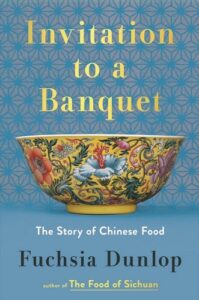If you visit a Shaoxing wine factory, you may walk past a stack of crumbly bricks made of some rough, pale, porous material. You’ll probably assume it’s debris left behind by negligent builders. But these bricks, this stuff, so unprepossessing to the eye, is one of the most important Chinese ingredients. You won’t see it in your bowl; you won’t smell or taste it directly; yet it’s an invisible presence in almost every Chinese meal. It is not merely an ingredient, but a pre-ingredient, the progenitor of some of the most vital components of Chinese edible culture. Like a genie, it brings Chinese food and drink to life.
The bricks are made of what is known as qu—which sounds like “choo,” but with a lovely softness—a sort of coral reef teeming with desiccated microorganisms, enzymes, moulds and yeasts that will spring into action in the presence of water, ready to unleash themselves on all kinds of foods, especially those that are starchy. The Japanese, who learned about qu from China, call it koji ; it’s sometimes translated into English as “ferment.” When awakened, all these microorganisms will magically transform cooked beans, rice and other cereals, unravelling their tight-knit starches into simple sugars, then fermenting the sugars into alcohol, meanwhile spinning off a whole aurora of intriguing flavors. It is qu that converts soybeans into soy sauce and jiang. Qu is the catalyst for fermenting alcoholic drinks from rice, millet and other cereals, as well as grain vinegars. It’s no exaggeration to say that qu is one of the keys to what makes Chinese food Chinese.
Since the Neolithic Age, people in China have been brewing alcoholic drinks from rice and millet. Transforming cereals into jiu (the general Chinese term for wines, ales and other types of liquor) presents particular challenges because, unlike grapes and other fruits, they lack accessible sugars that yeasts can devour and turn into alcohol. Before they can be fermented, the starches in the grains have to undergo saccharification, a process of hydrolysis that breaks them up into sugars that yeasts can digest. Making alcohol from grains is always a multi-stage process, more complicated than fermenting wine from grapes—which, as HT Huang says, is spontaneous and “practically unavoidable” because of the sugars in the fruit and the yeasts on their skins. Since grains, unlike grapes, have no natural enthusiasm for fermentation, they need encouragement. In northern Europe, malted grains are used to coax cereals into beer. But in China, people also worked out, very early on, how to harness the power of qu and its powerful collection of agents, including molds from the families Aspergillus, Rhizopus and Mucor.
It’s no exaggeration to say that qu is one of the keys to what makes Chinese food Chinese.
The qu used to brew Chinese wines and vinegars is made from ground grains, pulses or a mixture of both, raw or cooked, and often mixed with aromatic herbs whose flavors will linger in the final product. The mixture is moistened, shaped into blocks and kept in dark, humid conditions that foster the growth of great colonies of molds and yeasts. When the blocks are suitably moldy, they can be dried out and kept for ages. There are many types of qu. You can probably find at least one in your local Chinese supermarket: pale, chalky balls or tablets that can be used to make your own sour-sweet rice wine. The qu used to ferment Shaoxing’s famous golden rice wine is made from ground wheat, while Sichuan’s Baoning vinegar is catalyzed by qu made from millet, wheat and sweet potatoes and infused with some twenty medicinal herbs. Other types of qu grow directly on the surface of foods that are the main ingredient of a fermented product: for example, broad beans are blanched, dusted with wheat flour and left to mold as part of the manufacture of Sichuan chilli bean paste, while cooked, flour-shaken soybeans are left to grow a coat of qu during the process of making soy sauce, jiang and fermented black beans.
How the Chinese discovered the wonders of qu and its role in making wine remains a mystery, but historical and archaeological evidence suggests this happened more than four thousand years ago and possibly much earlier. HT Huang surmises that the earliest rice and millet wines made in China, which date back to the Neolithic period, were probably saccharified by the enzymes in sprouted grains, much as beer is made today (sprouted grains are no longer used in China to make wines, but are still employed there to turn starchy cereals into malt sugar, as they have been for thousands of years). Some time later, he suggests, people must have noticed that wines made with cooked grains that had been contaminated with mould turned out especially fragrant, and then realized they could dry and store such moldy grains without any loss of potency.
In any case, by the sixth century the first detailed recipes for cultivating qu appeared, in Jia Sixie’s agricultural treatise Essential Skills for the Common People (qimin yaoshu). Four chapters explained methods for making nine types of qu, which could then be used to manufacture thirty-seven kinds of alcoholic brew. Only one kind of qu was made from millet, the rest from wheat in various proportions of raw and cooked grains, all ground up and mixed with water. The grainy pastes, sometimes infused with herbs, were shaped into cakes and fermented in special sheds with scrupulous attention to hygiene and ambient conditions. The transformational qualities of qu were acknowledged in the magical aspects of Jia’s recipes, one of which involves sacrificial incantations and prostrations before the spirits. One superior type of ferment was even called shen qu, “miraculous qu .” Jia’s ferments were not only used in the manufacture of alcoholic drinks and fermented soy products, but also fermented meat and fish pastes.
There is no aspect of Chinese food culture that fails to fascinate me, but I have barely opened the door on the subject of jiu, a vast field concerned with the fermentation and appreciation of mellow rice wines, searing sorghum liquors and other alcoholic beverages. Chinese friends and acquaintances have often lambasted me for my lack of interest in wine: “We call it food and drink culture, yinshi wenhua, the two are completely intertwined, how can you be so obsessed with Chinese food and yet ignore jiu ?” There are two reasons for my avoidance of matters of jiu. The first is intellectual: Chinese food is a subject so rich and voluminous that it will keep me occupied until the day I die; I don’t have room in my head to explore the equally bottomless topic of alcohol. The second is practical: I cannot think deeply about food, discuss it with dining companions and take prolific notes when drunk.
As anyone Chinese or any foreigner who has lived in China will know, it’s hard to drink moderately while feasting in China. Once you have participated in a first round of toasting, usually with fiery baijiu (distilled grain liquor), toast will follow toast, unavoidably and inexorably, until you are lost. It is generally considered impolite at a Chinese dinner party to sip alcohol at one’s own pace. As a woman, however, I have one major advantage, which is that there is still less social pressure on women to drink than on men, and if I say at the beginning of a banquet that I’m teetotal, I can usually get away with it. One exception was during a trip a few years ago to Shandong, where the toasting was more gung-ho, ritualistic and irresistible than anywhere else I’ve known, and I was forced into inebriation at almost every meal. The chaotic state of my notebooks from that trip, the handwriting sliding and crashing across the page, is a permanent reminder of those riotous days and nights.
But alcohol also has its culinary aspects. Strong liquors are used to inhibit bacterial growth when pickling: every Sichuanese granny will add a dash of baijiu to her pickle jar. Baijiu is occasionally also used in cooking, as in the Shanghainese favorite of stir-fried burr medic leaves “with the fragrance of wine” (jiu xiang caotou). More commonly in many parts of China, a bottle of milder cooking wine, liaojiu, is a kitchen staple—like the basic Shaoxing wines you can find in every Chinese supermarket. Such wines, which have a similar alcoholic potency to sherry, are routinely used to dispel the “off-tastes” in fishy and meaty ingredients that Yi Yin talked about thousands of years ago, and which my teachers at the Sichuan cooking school mentioned in every class. Rice wine, along with salt, ginger and spring onions, shows up in marinades for fish, meat and poultry, and is used especially generously with ingredients such as red meats, kidneys and other offal where these unsavory notes are more pronounced. A dash of Shaoxing wine really does seem to refine the flavor of a steamed fish and to harmonize the flavors of a pork stock or stew. It is seldom added to vegetable dishes.
Another kind of jiu lends its delicate fragrance to sweet dishes across China, and can easily be made at home: fermented sticky rice wine, known as laozao in Sichuan, sweet jiu in Hunan and jiuniang in the Jiangnan region. Brewing your own laozao is one way to experience the magic of qu. All you need do is soak and then steam some sticky rice, mix it, while still faintly warm, with some powdered qu (buy a ball of wine yeast and pulverize it with a pestle and mortar), place it in a deep, spotlessly clean pot, make a well in the centre of the rice, cover the bowl and leave it in a warm place for a few days. During its seclusion, a miracle occurs: the microbes in the qu energetically digest the rice, transforming the pale starch into an array of sugars, lactic acid, amino acids, alcohol and aromatic molecules with a corresponding range of flavors, leaving behind what the food and science expert Harold McGee describes as the ‘ghosts’ of the rice, pappy grains floating in a fragrant liquid. This wine is sometimes used in steaming fish or marinating pork, but is most often found in the soupy desserts that the Chinese adore. One speciality of the Jiangnan region is jiuniang yuanzi, a sweet, faintly boozy soup in which sticky riceballs float among wisps of egg and tiny, golden osmanthus flowers. Women in Sichuan are nourished with a similar dish, with poached eggs added, after childbirth. (Unstrained or cloudy wines like this have been drunk in China for thousands of years; one, supposedly enjoyed by the concubine of the Tang Dynasty emperor Xuanzong, Yang Guifei, is offered by restaurants in the old Tang capital, Xi’an.)
While rice wine is used in cooking across China, it is in the Jiangnan region that it comes into its own, not merely as a corrective for undesirably fleshy flavors or a seasoning for sweet dishes, but as a significant flavoring in its own right. And as you might expect, there are few better places to explore the culinary uses of jiu than Shaoxing, the City of Yellow Wine, which has been a Chinese center of wine production for more than two millennia.
During a visit to Shaoxing a few years ago, I was shown around the Tang Song wine factory by a member of its staff, Han Jianrong. He explained how Shaoxing wine was the product of a particular terroir, its ingredients sticky rice, a mixture of well water and water from the nearby Jian Lake that was rich in minerals and, of course, the magical qu. Every year, he said, at the start of the winter production season, they made sacrifices to the spirit of the “Immortal of Wine,” the Tang Dynasty poet Li Bai, renowned for his infatuation with drinking. To make the wine, they soaked the rice for fifteen days, steamed it (“in the past, over a wood fire”), spread it out to dry on bamboo mats, fermented the grains with qu, then pressed them to extract the liquid, which was pasteurized before decanting into handmade clay jars to mature for up to thirty years. One great storage room in the factory was stacked with these clay tanzi, their outsides striped with streaks of cleansing lime, their mouths sealed with lotus and bamboo leaves and rice husks mixed with clay. “The earthenware jars are essential,” said Han.”They add a certain fragrance, like the clay pots used to brew tea.”
The finished wines have a color that ranges from amber to garnet red, which is why they are known as “yellow wines” (huangjiu). After our tour of the factory, Han invited us to a tasting. “Shaoxing wine is similar to Japanese sake in its balance of sweetness, sourness and alcoholic strength, as well as its complex umami flavors, derived from the many amino acids generated by the fermentation,” he said. There are four main classes of Shaoxing wine, ranging from dry to sweet. Interestingly, they may be blended together at table to taste, with a little sweet wine, for example, added to a dry wine for guests with a sweet tooth. Those that are medium-dry have the most harmonious balance of sour, sweet, bitter, pungent, spicy and astringent tastes, said Han, so they are the usual style for drinking, and for cooking certain classic dishes. “To make drunken crabs,” he said, “I’d recommend an eight-year-old Huadiao.”
The Chinese have always viewed alcohol as a medicine that revitalizes the blood, and the factory also makes tonic wines infused with herbs and other traditional remedies. But rice wine also has medicinal functions in everyday eating. It’s an essential accompaniment to hairy crabs, for example, because, according to traditional dietetics, its “warming” qualities are thought to combat the crabs’ potentially dangerous froideur. Grain alcohols of any sort are rarely drunk with staple foods: people say the combination of booze and cereals can encourage an unhealthy fermentation in the stomach. This is why, at Chinese banquets, grain foods are never served until the end of the meal, when all the toasts have been drunk and the cai, the dishes, enjoyed. If you accept an offer of rice or noodles towards the conclusion of a formal Chinese dinner, this will be interpreted as a signal that you have had enough to drink.
Shaoxing is one of the few cities in Jiangnan whose old canal-town atmosphere has survived the ravages of several decades of reckless urban development and excessive tourism. You can stroll down a street of grey-tiled, whitewashed houses, with narrow alleys leading down to the bank of a canal where stone steps disappear into the water. Old-fashioned shops sell medicinal herbs from wooden drawers or dispense Shaoxing wine and pickles. In a courtyard, someone has spread out on a bamboo mat a whole shoal of tiny, silvery fish that are drying in the bright sunlight. An old man sells goose eggs stewed with spices, crackled like old marble, and deep-fried fish to nibble. Down by the canal, residents sit on shady, waterfront terraces, surrounded by potted plants: tomatoes, aubergines and brightly colored flowers. In the shade of a tile-roofed colonnade along the water, a street vendor makes wafers in a blackened iron over a charcoal grill, stuffing them with nuts and sugar before they harden as they cool. Opposite, a man washes his clothes in a basin.
Locals say that Shaoxing has a “three-crock culture,” so central to its life and livelihood are the clay urns used to mature wine, soy sauce and dyes for the textile trade. The old streets are haunted by the scents of fermentation, especially the heady aroma of meigancai, a local preserve made by salting and then sun-drying mustard greens. Shops sell meigancai of different types and vintages, dried fish and fermented tofu. There are clay jars of Shaoxing wine in their woven bamboo cradles; some are brightly painted with auspicious symbols. In Shaoxing, lives used to be measured in wine. “Haircut wine” (ti tou jiu) was quaffed to mark the first haircut of a newborn baby when it was one month old. Jars were laid down upon the birth of a daughter, to be drunk at her future wedding (some Shaoxing wine is still called “daughter in red,” nu’er hong, red being the festive color of weddings and other celebrations).
Even the touristy center of the old town, where gaggles of schoolchildren troop round the former home of Lu Xun, China’s acclaimed modernist writer, retains some of its old-fashioned charm. A calligrapher paints lines of poetry on fans to order. Local sampans with woven bamboo awnings, all painted black, drift by on a stretch of canal. A low building in the traditional style with an open front has a great sign that says “Universal Prosperity Tavern (xianheng jiujia).” Here, you can sit at a wooden table, sipping Shaoxing wine and nibbling chewy broad beans infused with the scent of star anise (huixiang dou) and lacquered sparrows’ wings, the local equivalents of crisps and pork scratchings in an English pub. The tavern is fiction made real: it was inspired by one of the same name in Lu Xun’s tale of a scorned, impoverished scholar, Kong Yiji.
It is not merely an ingredient, but a pre-ingredient, the progenitor of some of the most vital components of Chinese edible culture.
The first time I visited Shaoxing, the executive chef of the Universal Prosperity Tavern invited my friends and me for lunch. Mao Tianyao, a modest, understated man, is one of the foremost custodians of Shaoxing culinary culture. He has written an entire book about meigancai, the adored local pickle, and has a contagious passion for the food of his hometown. Before we began to eat, we drank some Shaoxing wine poured from a xihu, an old-fashioned tin carafe with fish decorations and a pointy spout like a teapot.
The dishes Mao served us that day were unlike anything I’d tasted in more than fifteen years of Chinese culinary adventures, and kindled in me an enduring love and fascination for Shaoxing flavors. Aside from the anise-perfumed beans, given iconic status by their appearance in Lu Xun’s tale, we ate cubes of belly pork steamed with dark meigancai, which gave the meat an almost Marmitey intensity of taste, and chunks of braised pork bound in bamboo leaves that were served cool with their jellied juices. There were quivering fish balls, soft as custard, in a soup with bamboo shoots and ham, and punchy fermented relishes.
Several dishes had been made with Shaoxing wine. Smoky-black jujubes, soused in wine, had a flavor like an alcoholic Lapsang Souchong tea, while a similar steeping gave dried fish its own “drunken” perfume. Another seasoning I’d not come across before was Shaoxing wine lees, jiuzao, the brown mulch of exhausted grains left behind after the fermentation of the wine. Dried out, it can be layered with salt fish, to which it lends its bewitching aroma; the mulch can also be boiled up with water, salt and other seasonings and then strained to make zaolu, a golden elixir with a floral fragrance and an umami intensity reminiscent of fish sauce, in which cooked ingredients such as offal, seafood and fresh vegetables can be steeped. On this occasion, Mao presented us with zao ji, strips of yellow-skinned chicken that had been poached and then steeped in a salty wine-lees brine; it was served in a clay jar, its flesh cold, taut and aromatic. “An essential New Year’s dish,” he said. “Once the chicken was made this way to preserve it for a week or so; now we do it for the flavor.”
The fragrance of Shaoxing wine is also employed in more oblique and imaginative ways, both in Jiangnan and beyond. Wine lees are mixed into the wet clay used to coat a roasted “beggar’s chicken,” where their particular scent combines deliciously with the perfume of the lotus leaves in which the bird is wrapped. Just as old oak wine casks may be used to lend flavor to maturing grape wines, a pottery jar, emptied of its Shaoxing wine, is the essential vessel for cooking the Fujianese banquet dish “Monk jumps over a wall,” fo tiao qiang: the scent of this opulent stew of dried abalone, shark’s fin, sea cucumbers and other luxuries, drifting over a temple wall, is said to be so irresistible that it will induce a monk to abandon his vow of vegetarianism. And of course, Shaoxing wine, used in lavish quantities, is key to what makes Dongpo pork so sublime.
Sometime before the Yuan Dynasty, a new kind of qu was cultivated. This was “red qu ,” created when, in certain conditions, red Monascus fungi flourish amid the moldy microbial cultures that grow on grains of rice. It was to become a speciality of southeastern Fujian Province, where it adds a rosy hue to some local wines and to stewed meats and other dishes prepared with the ruddy, mashy residue from wine-making. “Red qu ” is also added to the brine used to cure a type of fermented tofu (known as “southern milk,” nan ru), giving the cubes a deep pink color. It is also a traditional food coloring, stamped on to sweet pastries and dumplings in dots and auspicious patterns. Most Chinese supermarkets in the west stock packets of dried “red qu rice,” in which the dried rice grains are covered in a purplish layer of mould that turns magenta when soaked in water.
Rice wine and all its associated dishes are, in my besotted view, only the start of the gastronomic attractions of Shaoxing. Local people’s penchant for fermented and preserved foods spins off in unconventional directions, in particular into a whole genre of what they call “stinky and rotten” (chou mei) delicacies. Stinky tofu, made by steeping slabs of plain white tofu in a brine made from fermented vegetables, is found across the Jiangnan region, but in Shaoxing this process is just the first step in some strangely compelling flavor adventures. People here make their stinky brine by harvesting woody, overgrown amaranth stalks, cutting them into inch-long sections and allowing them to decompose in a clay jar until they smell as disgusting as a blocked drain. The stems themselves acquire a heady aroma that is both disturbing and compelling; locals steam them on a bed of silken tofu or a minced pork patty, to which they lend their funky flavor; the tubular stems can then be sucked dry of their vestiges of skin and pulp. Their fermentation brine is used for steeping not only tofu, but other ingredients such as green vegetables and chunks of pumpkin, which it infuses with a thrilling, fair-foul aroma, as seductive as the scent of a ripe Camembert. These stinky foods, along with preserved vegetables and dried fish, strike a distinctive chord with the mellowness of Shaoxing wine, one that is found in no other Chinese cuisine.
Similar to chicken steeped in wine lees is “drunken chicken,” soaked in a salty brine based on Shaoxing wine, which is properly served in an earthenware pot and one of a whole family of “drunken” dishes. In some, the ingredients are more literally intoxicated. In the late 1990s, a friend in Shanghai gave me my first taste of drunken crab, made by sousing live freshwater crabs first in strong baijiu liquor and then, for a day or two, in Shaoxing wine flavored with soy sauce and sugar and laced with aromatics. Traditionally, the sozzled crabs, by now expired, are eaten raw—a local exception to the general rule that the Chinese shun uncooked foods (with the excuse that alcohol is said to inhibit dangerous bacteria and the ingredients are transformed from their raw state by a kind of pickling). That drunken crab initiation will be impressed on my tongue for ever. Ice-cold and vividly slimy, with a scintillating kick of liquor, the flesh and ovaries of the crab made me shiver with pleasure. They were as creamily voluptuous as foie gras, yet simultaneously as brisk and arresting as a raw oyster. Of all the delicious things I have eaten in my life, I would place raw drunken crabs near the peak of gastronomic pleasure.
Recently, when raw drunken crabs were banned by the Shanghai local authorities on health grounds, I discovered that they, like other raw freshwater creatures, can carry nasty parasites such as liver fluke—a reminder of why human beings might try to avoid “drinking blood and eating feathers.” These days, law-abiding Shanghai restaurants only serve drunken crabs after steaming: while still delicious, they lack that visceral twang of ecstasy. Raw drunken crabs have become an illicit pleasure, exciting and risky, available only by special order in private dining rooms. Here, Shanghainese sophisticates can still suck at the wet, briny ovaries of a raw crab and walk on the wild side, the side that still strains at the leash of civilization and yearns to run naked through the forest. As for myself, while I generally avoid the drunkenness of baijiu, I embrace the intoxicating pleasures of drunken dishes, especially crabs. So far (touch wood), I’ve been spared the liver flukes and other unwelcome visitors. Like the seventeenth-century writer Li Yu, I dream of crabs, and I dream of them drunken.
__________________________________
Excerpted from Invitation to a Banquet: The Story of Chinese Food by Fuchsia Dunlop. Copyright © 2023. First published in 2023 in Great Britain by Penguin UK. Used with permission of the publisher, W. W. Norton & Company, Inc. All rights reserved.
This post was originally published on this site be sure to check out more of their content.









